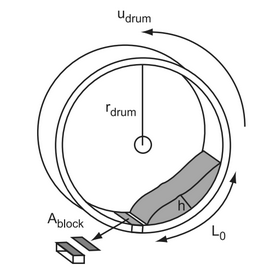Contact:
Name:
Hsu, Leslie
Institution:
Lamont-Doherty Earth Observatory, Columbia University
contributor_email:
We conducted laboratory experiments to test the hypothesis that bedrock erosion is related to grain collisional stresses which scale with shear rate and particle size. We placed granular material in a 56-cm-diameter rotating drum to explore the relationship between erosion of a synthetic bedrock sample and variables such as grain size, shear rate, water content, and bed strength. Grain collisional stresses are estimated as the inertial stress using the product of the squares of particle size and vertical shear rate. Our uniform granular material consisted of 1-mm sand and quartzite river gravel with means of 4, 6, or 10 mm. In 67 experimental runs, the eroded depth of the bed sample varied with inertial stresses in the granular flow to a power less than 1.0 and inversely with the bed strength. The flows tended to slip on smooth boundaries, resulting in higher erosion rates than no-slip cases. We found that lateral wall resistance generated shear across the channel, producing two cells whose widths depended on wall roughness.
Date Last Updated:
Tuesday, November 4, 2014
Image:

Language:
English
Rights management:
CC-BY
Coverage:
Location:
Geolocation is 37.9153639, -122.33468490000001
Dates Collected:
Wednesday, January 1, 2003 to Thursday, January 1, 2004
Resource Type:
dataset
Degree of processing:
2: derived